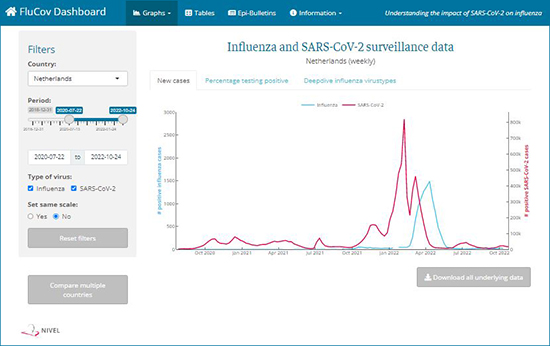FluCov: Influenza-COVID-19, understanding and communicating the co-circulation of influenza and COVID-19
Duration: Mar 2021 - Dec 2025
- Sign up here to receive the monthly FluCov bulletin via email
 Background
Background
On 1 January 2020, the World Health Organisation (WHO) requested information on a reported cluster of atypical pneumonia cases in Wuhan from the Chinese authorities. On 1 March 2020, WHO made the assessment that SARS-CoV-2 could be characterized as a pandemic. The emergence of this new virus has had a major impact on the global circulation of respiratory viruses, including influenza and RSV. The end of the pandemic was announced on 4 May 2023, with SARS-CoV-2 being an established virus which continues to circulate globally.
Participating countries
A number of 25 contextual and geographical representative countries have been selected:
- Africa (2): Egypt, South Africa
- America (6): Argentina, Brazil, Canada, Chile, Mexico, United States
- Europe (8): France, Germany, Israel, Italy, Netherlands, Poland, Spain, United Kingdom
- South Asia (4): India, Philippines, Thailand, Vietnam
- Pacific (5): Australia, China, Japan, New Zealand, South Korea
 Aim
Aim
The FluCov project aims to provide a situation analysis of influenza and SARS-CoV-2 co-circulation in relation to other respiratory pathogens, when relevant. This information is critical for the assessment and development of public health implications for influenza vaccine composition, coverage, and policies in the coming years.
 Project design
Project design
The research project consists of six components:
- Developing an integrated Bulletin for acute respiratory pathogens using data from WHO FluNet and other key sources with a primary focus on influenza and SARS-CoV-2
- Further maintaining the existing FluCov Dashboard on the Nivel website and exploring ways to extend the project, notably to new pathogens e.g. avian influenza
- Assessing how the FluCov Dashboard on the Nivel website can be further enhanced by adding new Bulletins and possibly also new sources of surveillance data
- Assessing the possible extinction of the B-Yamagata influenza virus
- Assessing the impact of the SARS-CoV-2 pandemic on influenza vaccine coverage rates around the world
- Writing a manuscript to describe and present the FluCov multi-pathogen surveillance website/ platform and results
 Results
Results
We share our research and findings by providing access to the FluCov Bulletins, posters, and survey results:
- A dashboard which allows visitors to query the influenza and SARS-CoV-2 data themselves
- Regular publications:
- the FluCov Bulletins of the epidemiological assessment on the impact of SARS-CoV-2 on influenza activity
- influenza activity reports: biweekly short publication of seasonal influenza activity, SARS-CoV-2 activity, and influenza viruses with pandemic potential
- Scientific publications:
- Abstracts
- regarding the epidemiological impact of the SARS-CoV-2 pandemic on influenza activity, which was submitted to ESCAIDE (European Scientific Conference on Applied Infectious Disease Epidemiology) in November 2021
- Contributions:
- two posters which were presented at Options XI: 1) the NIC survey results and 2) the modelling study/strategy (by EHESP)
- poster presented at ESCMID Global 2024: quantitative analysis of influena B/Yamagata surveillance data
- oral presentation online at the 8th ESWI influenza conference: influenza vaccine coverage rate
- Poster presented at OPTIONS XII in September 2024: results of three years the FluCov project
- Scientific publication (research article): A Missed Opportunity? Exploring Changes in Influenza Vaccination Coverage During the COVID-19 Pandemic: Data From 12 Countries Worldwide (Influenza and Other Respiratory Viruses)
- Scientific publication (viewpoint): post-disappearance scenarios: policy implications following the potential disappearance of B/Yamagata lineage influenza viruses (Eurosurveillance)
- Scientific publication (research article): Probable extinction of influenza B/Yamagata and its public health implications: a systematic literature review and assessment of global surveillance databases (The Lancet Microbe)
- Scientific publication (Letter to the editor): influenza vaccine coverage rate during the COVID-19 pandemic (Eurosurveillance)
- Scientific publication (research article): modelling the susceptible population for the 2022/23 influenza season (Influenza and Other Respiratory Viruses)
- Report: landscape analysis of modelling activities regarding the impact of SARS-CoV-2 on influenza activity
- Scientific publication (research article): survey among National Influenza Centers about the impact of the SARS-CoV-2 pandemic on influenza surveillance (Influenza and Other Respiratory Viruses)
Result 1: FluCov Dashboard, the impact of SARS-CoV-2 on influenza
The emergence of SARS-CoV-2 in 2019 had a major impact on the global circulation of respiratory viruses, including influenza (see https://www.nature.com/articles/s41467-022-29402-5). In order to understand the impact of SARS-CoV-2 on influenza activity worldwide, and more recently their co-circulation, the FluCov Dashboard offers users a clear view of the current and past circulation of both viruses (since 2019), in a wide range of countries all over the world. Real-time weekly surveillance weekly data are downloaded and presented in the Dashboard.
Results 2 and 3: FluCov Bulletins, scientific publications, survey results, posters
- FluCov Influenza Activity Reports - (biweekly update from 2025), starting 22 Nov 2023
- FluCov Influenza Activity Report 2025 #12
- FluCov Influenza Activity Report 2025 #11
- FluCov Influenza Activity Report 2025 #10
- FluCov Influenza Activity Report 2025 #9
- FluCov Influenza Activity Report 2025 #8
- FluCov Influenza Activity Report 2025 #7
- FluCov Influenza Activity Report 2025 #6
- FluCov Influenza Activity Report 2025 #5
- FluCov Influenza Activity Report 2025 #4
- FluCov Influenza Activity Report 2025 #3
- FluCov Influenza Activity Report 2025 #2
- FluCov Influenza Activity Report 2025 #1
- FluCov Influenza Activity Report #22
- FluCov Influenza Activity Report #21
- FluCov Influenza Activity Report #20
- FluCov Influenza Activity Report #19
- FluCov Influenza Activity Report #18
- FluCov Influenza Activity Report #17
- FluCov Influenza Activity Report #16
- FluCov Influenza Activity Report #15
- FluCov Influenza Activity Report #14
- FluCov Influenza Activity Report #13
- FluCov Influenza Activity Report #12
- FluCov Influenza Activity Report #11
- FluCov Influenza Activity Report #10
- FluCov Influenza Activity Report #9
- FluCov Influenza Activity Report #8
- FluCov Influenza Activity Report #7
- FluCov Influenza Activity Report #6
- FluCov Influenza Activity Report #5
- FluCov Influenza Activity Report #4
- FluCov Influenza Activity Report #3
- FluCov Influenza Activity Report #2
- FluCov Influenza Activity Report #1
- FluCov-Bulletins (monthly) starting in June 2021)
- FluCov-Bulletin July 2025
- FluCov-Bulletin June 2025
- FluCov-Bulletin May 2025
- FluCov-Bulletin April 2025
- FluCov-Bulletin March 2025
- FluCov-Bulletin February 2025
- FluCov-Bulletin January 2025
- FluCov-Bulletin December 2024
- FluCov-Bulletin November 2024
- FluCov-Bulletin October 2024
- FluCov-Bulletin September 2024
- FluCov-Bulletin August 2024
- FluCov-Bulletin July 2024
- FluCov-Bulletin June 2024
- FluCov-Bulletin May 2024
- FluCov-Bulletin April 2024
- FluCov-Bulletin end-March 2024
- FluCov-Bulletin mid-March 2024
- FluCov-Bulletin end-February 2024
- FluCov-Bulletin mid-February 2024
- FluCov-Bulletin end-January 2024
- FluCov-Bulletin mid-January 2024
- FluCov-Bulletin end-December 2023
- FluCov-Bulletin mid-December 2023
- FluCov-Bulletin November 2023
- FluCov-Bulletin October 2023
- FluCov-Bulletin September 2023
- FluCov-Bulletin August 2023
- FluCov-Bulletin end-July 2023
- FluCov-Bulletin mid-July 2023
- FluCov-Bulletin June 2023
- FluCov-Bulletin May 2023
- FluCov-Bulletin April 2023
- FluCov-Bulletin March 2023
- FluCov-Bulletin end-February 2023
- FluCov-Bulletin mid-February 2023
- FluCov-Bulletin end-January 2023
- FluCov-Bulletin mid-January 2023
- FluCov-Bulletin end-December 2022
- FluCov-Bulletin mid-December 2022
- FluCov-Bulletin end-November 2022
- FluCov-Bulletin mid-November 2022
- FluCov-Bulletin October 2022
- FluCov-Bulletin September 2022
- FluCov-Bulletin August 2022
- FluCov-Bulletin July 2022
- FluCov-Bulletin June 2022
- FluCov-Bulletin May 2022
- FluCov-Bulletin April 2022
- FluCov-Bulletin March 2022
- FluCov-Bulletin February 2022
- FluCov-Bulletin January 2022
- FluCov-Bulletin December 2021
- FluCov-Bulletin November 2021
- FluCov-Bulletin October 2021
- FluCov-Bulletin September 2021
- FluCov-Bulletin June 2021
- Global Influenza Initiative (GII) infographics and newsletters
- Infographic May 2025
- Infographic DANFLU-1: An Innovative Pragmatic Randomised Feasibility Trial of Influenza Vaccines
- Infographic Cardiologists’ knowledge and perceptions of the seasonal influenza immunisation
- Infographic August 2024
- Infographic July 2024
- Infographic April 2024
- Infographic March 2024
- Infographic February 2024
- Infographic January 2024
- Infographic November 2023
- Infographic September 2023
- Infographic July 2023
- Infographic June 2023
- Infographic April 2023
- Infographic March 2023
- InfluNews, issue 1, January 2023
- InfluNews, issue 7, November 2022
- InFluNews, issue 1 - February 2022
- InFluNews, issue 5 - September 2021
- Infographic InFluNews, issue 5, September 2021
- InFluNews, issue 4 - July 2021
- InFluNews, issue 3 - June 2021
- Infographic InFluNews, issue 3, June 2021
- InFluNews, issue 2 - April 2021
- Infographic InFluNews, issue 2 - April 2021
- InFluNews, issue 1 - March 2021
- Infographic InFluNews, issue 1 - March 2021
- Posters
- Poster presented at OPTIONS XII in September 2024: results of three years the FluCov project
- FluCov NIC Survey, presented at OPTIONS XI, 26-29 September 2022
- EU5 Modelling to produce influenza activity scenarios, presented at OPTIONS XI, 26-29 September 2022
- FluCov EpiBulletin, presented at WHO-ISIRV conference "COVID-19, Influenza and RSV: Surveillance-Informed Prevention and Treatment, 19-21 October 2021
- Scientific publications
- 2025 | A missed opportunity? Exploring changes in influenza vaccination coverage during the COVID-19 pandemic: data from 12 countries worldwide. Del Riccio, M., Guida, A., Boudewijns, B., Heemskerk, S., Summeren, J. van, Schneeberger, C., Stelma, F., Velden, K. van der, Timen, A., Caini, S. Influenza Other Respi Viruses. 2025
- 2024 | Post-disappearance scenarios: policy implications following the potential disappearance of B/Yamagata lineage influenza viruses. Del Riccio, M., Nunes, M.C., Cowling, B.J., Lina, B., McCauley, J.W., Meijer, A., Nohynek, H., Boudewijns, B., Caini, S. Euro Surveill. 2024
- 2024 | Probable extinction of influenza B/Yamagata and its public health implications: a systematic literature review and assessment of global surveillance databases. Caini, S., Meijer, A., Nunes, M.C., Henaff, L., Zounon, M., Boudewijns, B., Del Riccio, M., Paget, J. Lancet Microbe. 2024
- 2023 | The impact of the SARS-CoV-2 pandemic on global influenza surveillance: insights from 18 National Influenza Centers based on a survey conducted between November 2021 and March 2022. Staadegaard, L., Del Riccio, M., Wiegersma, S., El Guerche-Séblain, C., Dueger, E., Akçay, M., Casalegno, J.S., Dückers, M., Caini, S., Paget, J. Influenza Other Respi Viruses.2023
- 2023 | Landscape analysis of modelling activities around the world regarding the impact of SARS-CoV-2 on influenza activity. Wiegersma, S., Del Riccio, M., Staadegaard, L., Paget, J. Utrecht: Nivel, 2023
- 2023 | Preparing for the upcoming 2022/23 influenza season: A modelling study of the susceptible population in Australia, France, Germany, Italy, Spain and the United Kingdom. Boudewijns, B., Paget, J. Del Riccio, M., Coudeville, L., Crépey, P. Influenza Other Respi Viruses. 2023
- 2021 | Letter to the editor: Increase of influenza vaccination coverage rates during the COVID-19 pandemic and implications for the upcoming influenza season in northern hemisphere countries and Australia. Del Riccio M, Lina B, Caini S, Staadegaard L, Wiegersma S, Kynčl J, Combadière B, MacIntyre CR, Paget J. Euro Surveill. 2021
- Presentations
- GII-MENA-RAISE Survey – Results
 Nivel project team
Nivel project team
Participating Nivel researchers are:
- Bronke Boudewijns, junior researcher
- Susanne Heemskerk, junior researcher
- Lotte van Heuvel, junior researcher
- Marco Del Riccio, MD, guest researcher
- Saverio Caini MD, PhD, guest researcher
- Foekje Stelma, MD-PhD, program lead
Project partners are:
- The Global Influenza Initiative (GII)
 Funding
FundingThe research project is funded by Sanofi. The current research grant runs until December 2025.
 Want to know more?
Want to know more?
For more information on this project, please feel free to get in touch with the Nivel expert(s) involved. You will find them on the right, together with the (future) Nivel deliverables (publications) and other relevant content.



